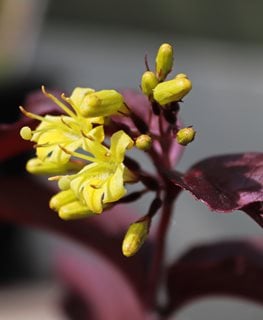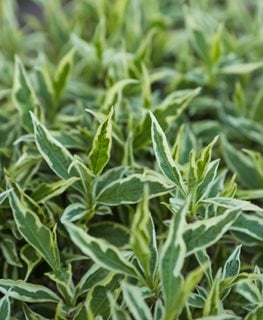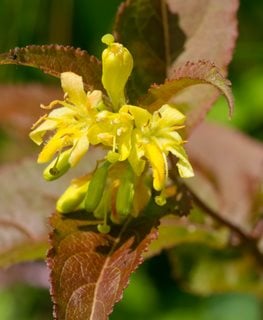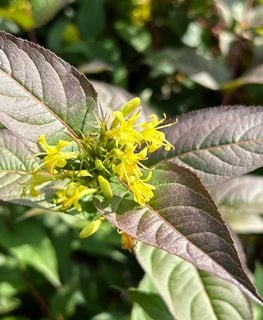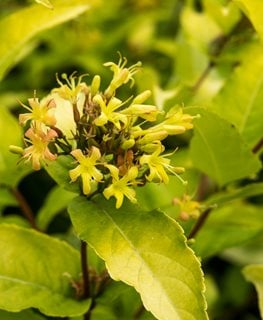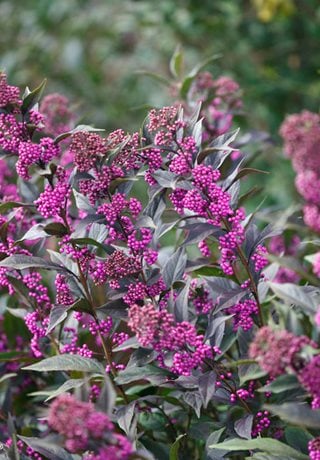HOW TO GROW & CARE FOR DIERVILLA IN YOUR GARDEN
Use these colorful landscape plants to liven up beds and borders in sun or shade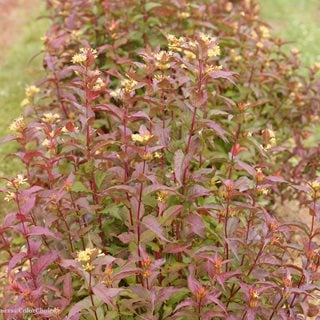
Kodiak® Orange diervilla. Photo: Proven Winners
Diervilla is a little-known and underused ornamental plant that deserves more attention from home gardeners. This deciduous shrub produces attractive lance-shaped leaves, clusters of tubular flowers in summer, and brilliant fall color. Newer cultivars have been bred in a range of dazzling foliage colors to liven up beds, borders, foundation plantings, and containers.
Native to eastern North America, Diervilla can be found growing along stream banks, rocky slopes, and in open woodlands. The common name of bush honeysuckle refers to the slender flowers which resemble true honeysuckle in the genus Lonicera. There are three species of Diervilla, including northern bush honeysuckle (Diervilla lonicera), southern bush honeysuckle (D. sessilifolia) and mountain bush honeysuckle (D. rivularis).
Diervilla is tolerant of a wide range of growing conditions including sun or shade, wet or dry soils, wind, and difficult sites such as dry shade where little else will grow. Here’s how to grow and use diervilla in your landscape.
On this page: Basics | Planting | Care | Pictures | Frequently Asked Questions | Landscaping Ideas
On this page:
- BASICS
- HOW TO PLANT DIERVILLA
- DIERVILLA CARE
- DIERVILLA VARIETIES
- FREQUENTLY ASKED QUESTIONS
- DESIGN IDEAS
DIERVILLA BASICS
Botanical name:
Diervilla spp.
Plant type:
Deciduous shrub
Zones:
3-8, depending on the variety
Exposure:
Full sun to full shade
Habit:
Dense, bushy, suckering habit
Height/Spread:
2 to 5 feet tall, depending on the variety
Bloom time:
Late spring through summer, depending on the variety
Flowers:
Clusters of small yellow or orange tubular flowers reminiscent of true honeysuckle appear from late spring through summer, depending on the variety. The flowers are a nectar food source for hummingbirds, butterflies, bees, and other insect pollinators.
Fruit:
Flowers are followed by inconspicuous non-ornamental seed capsules 1/4 inch or longer.
Foliage:
Pointed oval-shaped leaves 3 to 6 inches long have slightly serrated edges. Varieties come in a range of colors including green, red, burgundy, gold, and variegated. Most varieties develop brilliant fall color in shades of red, orange, or yellow.
Toxicity:
Diervilla does not appear to be toxic to humans or pets, though mild digestive upset can occur if any non-edible plant is ingested.
HOW TO PLANT DIERVILLA
When to plant:
Plant diervilla during milder months in spring or fall to avoid stress from extreme heat or cold.
Where to plant:
Choose a site with full sun to partial shade and rich, well-draining soil.
How to plant:
Loosen soil in the planting area and amend with compost or other rich organic matter. Dig a hole twice as wide and the same depth as the root ball. Remove plant from the nursery container and tease out roots if potbound. Place in the hole so the top of the root ball is level with the surrounding soil. Fill in the hole with soil, tamp down gently, and water thoroughly. Water regularly until plants are established. Space plants 2 to 5 feet apart, depending on the variety.
DIERVILLA CARE
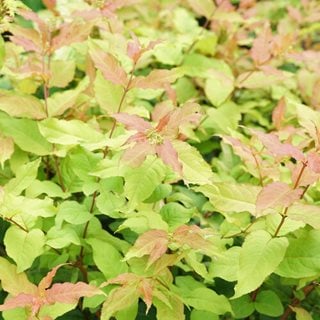
Kodiak Fresh® diervilla. Photo: Proven Winners
Soil:
Diervilla can tolerate clay, sandy, and rocky soils, though it prefers rich, well-drained soils with a pH of 6.0 to 8.0. Poorly draining soil can lead to root rot. For containers, use a high-quality all-purpose potting mix.
Amendments & fertilizer:
Newly planted diervilla will benefit from an application of a slow-release all-purpose fertilizer. Established plants need no fertilizing.
Watering:
Diervilla prefers low to moderate amounts of water and is drought tolerant once established. Avoid overwatering to prevent root rot.
Pruning:
Diervilla blooms on the current season's growth. When plants have finished flowering, prune back by up to 1/3 of the total plant size and shape as needed. Remove any dead, diseased, or broken branches.
Pests and diseases:
Diervilla is free of most pests and diseases. Pests may include aphids or scale. Diseases include leaf spot, powdery mildew, or root rot.
DIERVILLA VARIETIES
FREQUENTLY ASKED QUESTIONS
Is diervilla deer resistant?
Diervilla is resistant to deer browsing, though deer will feed on almost any plant if other food sources are scarce.
Will diervilla grow in shade?
Diervilla tolerates a wide range of light conditions, from full sun to full shade. If plants are grown in deep shade, they will produce fewer flowers and the foliage color will be less intense.
Does diervilla spread?
Diervilla plants spread through suckering roots to form dense colonies or thickets. Allow enough room for plants to naturalize. Control spread if needed by cutting back the root suckers around the outer edges. The suckering spreading habit makes diervilla a good choice for erosion control.
How big do diervilla get?
Diervilla is a small to medium-sized shrub that reaches 2 to 5 feet tall and wide at maturity, depending on the variety. Some may spread as much as 8 feet wide.
Is diervilla invasive?
Diervilla is sometimes confused with plants in the Lonicera genus that go by the same common name of bush honeysuckle. Lonicera are non-native shrubs which were introduced from Asia and Europe and can be invasive in many regions. Diervilla is not invasive.
DIERVILLA LANDSCAPING TIPS
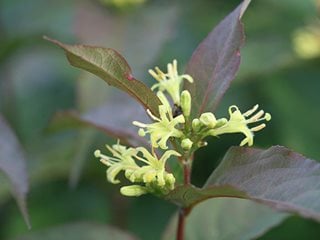
Summer flowers & foliage of Kodiak® Red diervilla. Photo: Proven Winners
For borders and landscapes:
Use diervilla towards the front of mixed borders, massed in the landscape, as hedging or screening.
For slopes and hillsides:
Mass diervilla along a slope or hillside where the suckering roots will stabilize the soil and help to stem erosion.
For containers:
Place a smaller specimen of diervilla in a container by itself.
There are many ways to use diervilla in your landscape. Here’s how:
- Plant in a wildlife-friendly garden to provide food for hummingbirds and insect pollinators, as well as shelter for ground-nesting birds.
- Use a row of diervilla along a property line for screening or to soften a fence, or as hedging to divide garden rooms.
- Add to a foundation planting alongside other shrubs with ornamental interest such as colored foliage or flowers for season-long color.
- Plant a smaller specimen in a decorative container and place as a focal point in the landscape.
- Allow diervilla to naturalize in a woodland setting or native border.
- Use as a ground cover along a slope where the suckering roots will stabilize the soil for effective erosion control.
- Naturalize along a stream or pond for multi-seasonal appeal.
Companion plants: Diervilla combines well with many other shrubs, perennials, and trees that thrive in the same growing conditions. Good companions include asters, coral bells, dogwood, elderberry, goldenrod, hosta, little bluestem, meadow rue, ninebark, paper birch, serviceberry, switchgrass, weigela, winterberry, and witch hazel.
RELATED:
21 Great Plants for Shade
22 Small Flowering Shrubs for Your Garden




